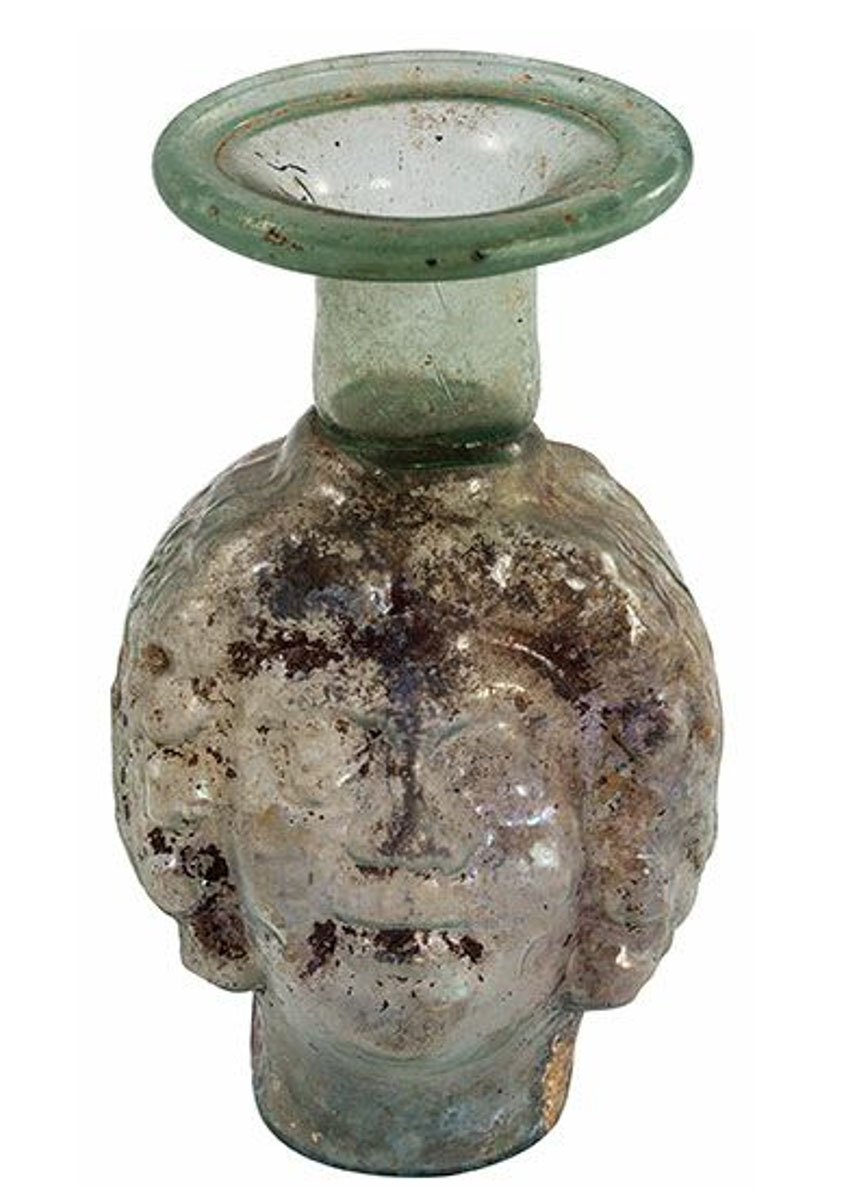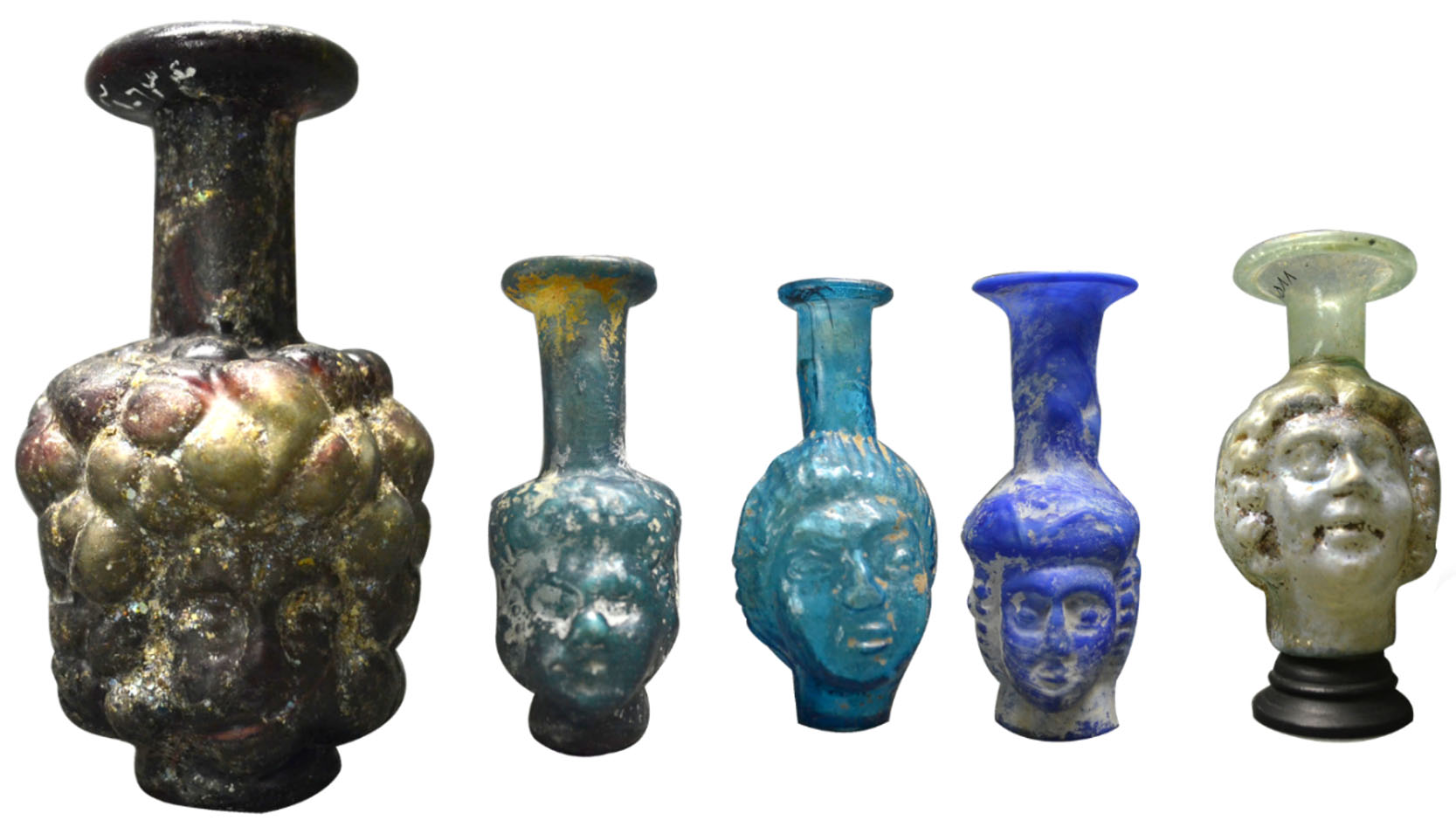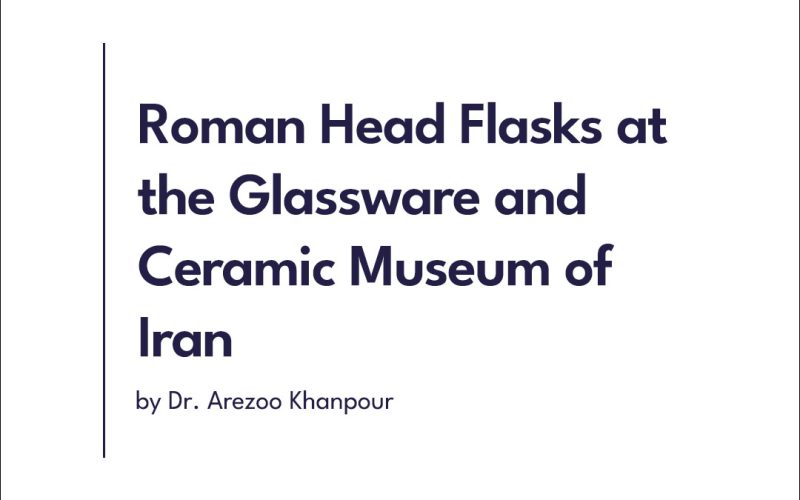Roman Head Flasks at the Glassware and Ceramic Museum of Iran
- by Dr. Arezoo Khanpour
Arezoo Khanpour is a specialist in glass art within the Faculty of Traditional Arts. As a designer and artist, she has been actively engaged in the field of glass art for the past two decades. Her research focuses on the history of glass art in Iran and worldwide, with numerous published articles on the subject. Her studies in glass art history have influenced her approach to form, pattern, color, and historical techniques in her works. Drawing inspiration from masterpieces in the history of glass, she aims to design and create contemporary Iranian glass artworks that not only preserve and revive cultural and artistic values but also contribute to defining the concept of Iranian identity in modern life.
The highly valuable Roman art of glassmaking in the early centuries AD, including its construction methods, decoration, and associated techniques, is worth studying. Human head-shaped containers are part of the Roman glass collection made using mold-blowing techniques from the 1st and 2nd centuries AD. A few examples of such artifacts are housed in the Glassware and Ceramic Museum of Iran.
Among the diverse and valuable glassworks displayed in this museum, six examples of Roman head flasks are showcased in the museum’s Crystal Hall. Due to their distinctive appearance, viewers often perceive them as foreign at first sight. This collection of head flasks dates back to the 1st century AD of the Roman Empire and were likely made in Syria or the Eastern Mediterranean. Roman glass art is particularly significant in the history of glassmaking for its innovations and advancements in tools, equipment, production, and decoration techniques. Head flasks are canteens blown into molds with bodies shaped like human heads. These were common in the Roman Empire, with most examples dating from the 1st to 4th centuries AD. Most examples feature two faces on either side of the vessel.
The primary factors in the evolution and development of Roman glass art in the early centuries AD include the widespread use of molds in production as glassblowing techniques were combined with glass casting and pottery mold processes. Glass molds were made from materials such as clay, stone, wood, and metal. Molds were generally multi-part structures that could be separated after the glass was blown into them, allowing the final product to be extracted.

The process of making mold-blown glass artifacts was influenced by molding techniques used in pottery. To create mold-blown vessels, molten glass was first blown into a decorated mold—one that often featured highly intricate geometric designs—transferring the designs onto the object. The patterns appeared on the raised parts of the glass object’s body. These objects were made throughout the Roman civilization but were especially popular and varied in the Eastern Mediterranean.
The use of molds in glassblowing gained attention from Roman glassmakers immediately after the invention of the blowpipe. “Mold-blown glass became popular and widespread in the 1st century AD. The first and most popular mold-blown glass products were made by glassmakers who likely migrated from the Eastern Palestinian region to the West. Among them, the first and most famous migrating glassmaker was a person named Ennion, who often inscribed his name on his works using mold designs” (Lightfoot, 2002, 22).
The use of animal forms, fruits, and human heads in the design and construction of the vessel body created three groups of small glass bottles that were made using molds in the early centuries AD in the Roman Empire. The first group consists of bottles with animal-shaped bodies, often using the form of a fish. This rare example is made using the blowing method in a mold, which is quite unique. The significance of this piece lies in its sculptural approach, where the lines present on the vessel add to its aesthetic value.
The second group consists of bottles with fruit-shaped bodies, often using the forms of dates and grape clusters, probably due to the abundance of these fruits in the region within that historical period and their symbolic importance. “These artifacts came from the Middle East, specifically from Phoenicia, Syria, or Palestine” (Barovier & et al, 2003, 43).
The third group consists of bottles whose bodies are shaped like human heads, which is the main subject of this article. The process of making head flasks in the early centuries AD in the Roman Empire illustrates the simultaneous development of molding and glassblowing techniques. Roman head flasks were usually made from transparent glass with colored tints.
Head flasks generally fall into three categories based on their appearance: single-faced, identical double-faced on either side of the bottle, and identical triple-faced of the same size. The third type is very rare and valuable. “These types of vessels have a symmetrical shape, with two identical faces on either side. The presence of symmetrical forms with different faces on either side of a vessel is exceptional and rare” (Qaeni, 2014, 90).
By studying the six examples of Roman head flasks in the Glassware and Ceramic Museum of Tehran, the technology behind their production is examined in detail. The Glassware and Ceramic Museum of Tehran contains a priceless collection of glass artifacts from historical periods both before and after Islam.
By studying the samples in the Glassware Museum of Tehran, we observe that the size of this group of head flasks ranges from approximately 8 to 10.4 centimeters. They are made from blue or transparent glass with a colored tint. Two of these head flasks are single-faced, with decorative and ornamental hair patterns molded on the back of the bottle. Three of them have two faces, symmetrically created using molds on either side of the bottle. The extremely rare and valuable example in this collection is the head flask with three faces, which are precisely and evenly spaced around the bottle. In this example, the curly hair decorations are emphasized.
Based on the research content presented in this article; the widespread use of molds, along with the invention of glass blowing techniques, is attributed to the first century AD. At each stage, glassmakers utilized capabilities from other fields, such as pottery and metalworking, to diversify and develop their works in line with the invention of new glass-making techniques. For instance, the use of common molds from ancient Roman pottery led to a parallel use for creating glass specimens in such synergistic developments.
This collection, which appears to have been purchased from a Jewish collector during the opening of the Glassware Museum, is considered a masterpiece of glass art history. It is preserved among the valuable heritage of Iranian glass art in the only specialized museum in this field in Iran.

Bibliography
- Qaeni, Farzaneh. 2014. Glassware and Ceramic Museum of Iran. Tehran: Cultural Heritage.
- Barovier & et al, 2003, Glass Throughout Time: History and Technique of Glassmaking from the Ancient World to the Present. Milan, Skira.
- Lightfoot, Christopher S. 2002. Ars Vitraria: Glass in the Metropolitan Museum of Art, New York: The Metropolitan Museum of Art.


